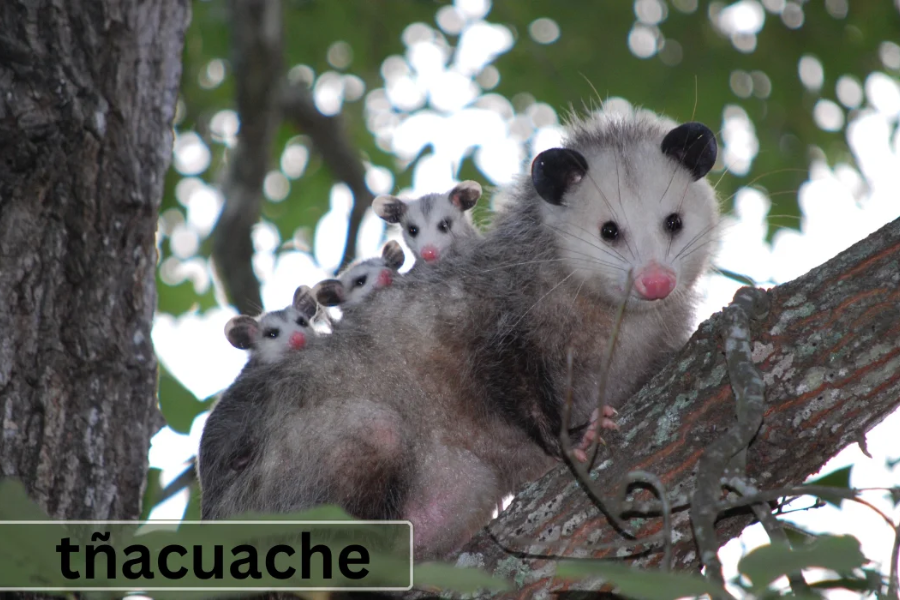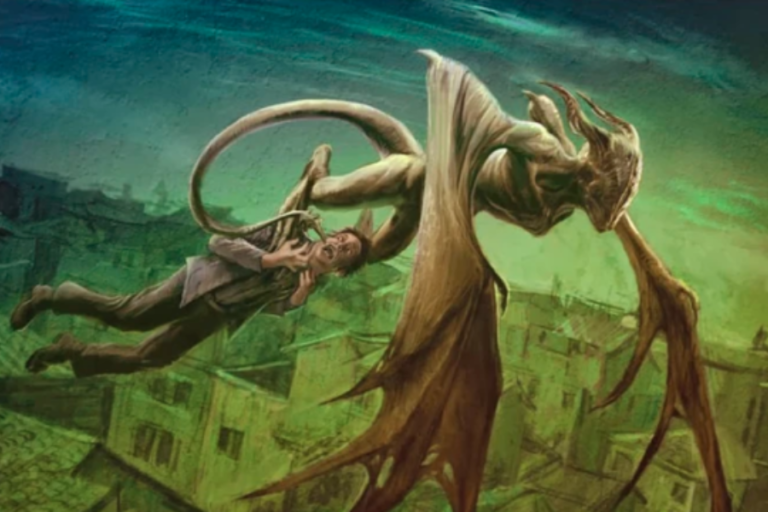Tñacuache: Mexico’s Trickster and Ecological Hero
In a quiet village tucked away in Mexico, a young boy named Luis grew up captivated by the enchanting stories his grandmother shared each night. The tales were always about a curious creature called the tñacuache. More than just an opossum, the tñacuache was portrayed as a wise, trickster figure with an important place in Mexican mythology and nature. As Luis listened by the fire, he learned that the tñacuache was more than just a nocturnal animal; it was a creature that bridged folklore and ecology, embodying survival, adaptability, and an ancient legacy.
The Myth and Legend of the Tñacuache
The tñacuache holds a special place in Mexican folklore and ancient Aztec mythology. According to legend, the tñacuache is responsible for bringing fire to humans. The myth recounts that when people were suffering in the cold, the tñacuache cunningly stole fire from the gods, hiding it in its tail. This heroic act, however, came at a cost; its tail was scorched and left hairless, a characteristic still seen in the species today. For Mexicans, this legend embodies the tñacuache’s bravery, cleverness, and self-sacrifice, making it a creature of reverence and mystery.
The Tñacuache’s Place in Mexican Culture
The tñacuache is a symbol of adaptation and persistence in Mexican culture, which are highly prized traits in indigenous customs. Much to the coyote in Native American mythology, this nocturnal animal is frequently thought of as a trickster. A perfect emblem of survival and intellect, the tñacuache navigates a difficult world with its cunning and brains.
The tñacuache also serves an ecological purpose within the community. Its scavenging habits contribute to a balanced environment by consuming insects, fruits, and even small animals. By controlling pests and dispersing seeds, tñacuaches help maintain the health of their habitats. In rural areas, people respect and value the tñacuache for its role as an environmental custodian, even if it occasionally causes mischief.
The Tñacuache in Modern Mexico
These days, tñacuaches may be found in Mexico’s busy metropolis as well as rural locations. Because of their propensity to rummage through trash, some city inhabitants may consider them pests, although environmentalists acknowledge their vital function in urban ecosystems. The importance of protecting the tñacuache and its role in biodiversity are highlighted by conservationists.
In Mexican art and literature, the tñacuache continues to appear as a beloved character. From children’s books to traditional folk art, the creature’s image is often used to evoke cultural pride and Mexico’s natural heritage. For children, stories about the tñacuache reinforce important values of resilience, cleverness, and respect for nature.
The Tñacuache’s Role in the Ecosystem
In addition to its symbolic meaning, the tñacuache is an important environmental object. They eat a variety of insects, small animals, fruits, and vegetables since they are omnivores, which helps manage pest populations and stops some plants from growing out of control. By consuming fruits and spreading their seeds through their droppings, tñacuaches support biodiversity and forest regeneration, which promotes healthier ecosystems.
Moreover, tñacuaches serve as prey for larger animals like owls, coyotes, and snakes, maintaining a balance in the predator-prey dynamics. This delicate role makes them indispensable to the ecosystem, linking various species and promoting ecological stability.
Conservation Activities and the Tñacuache’s Future
Despite its importance, the tñacuache faces numerous challenges, particularly from habitat loss and urban encroachment. Deforestation and expanding cities are forcing tñacuaches into closer contact with humans, leading to conflicts where they are sometimes considered nuisances. However, conservation efforts are underway to protect these creatures and their habitats. Environmental organizations in Mexico are actively promoting coexistence initiatives, which include creating secure garbage containers to reduce wildlife interactions and establishing protected areas for tñacuache populations.
These conservation efforts aim to minimize human-wildlife conflicts and encourage the safe and respectful coexistence of urban residents with tñacuaches. Additionally, educational campaigns help raise public awareness of the ecological significance of the tñacuache, emphasizing its vital contributions to biodiversity and ecosystem health.
The Symbolic Legacy of the Tñacuache
The tñacuache embodies not just ecological significance but also the enduring qualities of resilience and adaptability. The stories of this creature, passed down through generations, inspire Mexicans to value and protect their natural heritage. As Mexico continues to modernize, the tñacuache remains a symbol of a harmonious relationship with nature, reminding people of the importance of preserving biodiversity and cultural traditions.
Protecting the tñacuache and other native species ensures that future generations will experience the wonder of these creatures and the wisdom contained in their stories. The tñacuache, both as an environmental hero and cultural icon, remains an essential part of Mexico’s identity.
Discover the Fascinating World of the Tñacuache: Nature’s Nocturnal Marvel
Not only does the tñacuache have cultural value, but it also has biological significance. Originally from the Americas, this mammal is known scientifically as the Virginia opossum (Didelphis virginiana) and is quite adaptable. An other characteristic that sets the tñacuache apart in the animal realm is its capacity to efficiently avoid predators by “playing dead” when threatened, a trait known as thanatosis.
Also Read: Leomorg: The Future of Technology and Innovation
Habitat and Distribution of the Tñacuache
- Tñacuaches* thrive across diverse environments, from lush tropical rainforests to dry arid regions. They are predominantly found in Central and North America, with significant populations in Mexico, the United States, and parts of Canada.
- Adaptability: They adapt well to both natural and urban environments, often scavenging for food in human settlements.
- Natural Preferences: In their natural habitats, tñacuaches prefer areas near rivers or streams where food sources are abundant.
- Climate Tolerance: Capable of withstanding both hot and cold climates, tñacuaches are among the most widely distributed marsupials.
Behavioral Adaptations of the Tñacuache
- Tñacuaches* are nocturnal creatures, making them most active at night, when they forage for food and avoid predators. Their solitary nature, combined with their prehensile tails, makes them adept climbers, allowing them to escape predators and navigate densely forested environments. When threatened, they utilize their famous defense mechanism—playing dead—to deter potential attackers. By remaining motionless and emitting a foul odor, they create the illusion of death, convincing predators to leave them alone.
The Diet of a Tñacuache
Tacuaches are omnivores, which means that they can adapt to a variety of food sources thanks to their varied diet of insects, small animals, fruits, and vegetables. To the dismay of those who live in urban areas, they frequently eat human waste and scavenge. However, they also play an important ecological role as scavengers and pest controllers, helping to reduce insect populations and clean up dead animals.
Contributions to Ecosystem Balance
The ecological role of the tñacuache extends beyond pest control. By dispersing seeds, they promote plant diversity and forest regeneration. Their presence in ecosystems also provides a food source for predators, and their scavenging helps maintain environmental cleanliness by breaking down carrion. These contributions make the tñacuache indispensable for ecosystem balance, benefiting both natural and human-influenced landscapes.
Tñacuache’s Nightlife: An Inside Look at Their Nightlife
Under the cover of darkness, tñacuaches forage, hunt, and scavenge, avoiding predators by staying hidden in trees or burrows. Equipped with sharp night vision and a keen sense of smell, they navigate their environments effectively, searching for food and returning to familiar feeding grounds.
Are Tñacuaches Dangerous to Humans or Pets?
Generally, tñacuaches pose little threat to humans or pets. While they may carry parasites like fleas and ticks, which can be transmitted to pets, they are more likely to flee than to engage when confronted. Their natural defense mechanism—playing dead—protects them from both predators and accidental conflicts with humans.
Tñacuache Predators and Survival Threats
Despite their remarkable adaptability, tñacuaches face threats from predators like coyotes, large birds, and domestic dogs. Additionally, human activities such as habitat destruction and road traffic result in significant tñacuache fatalities. Nevertheless, their high reproduction rate allows them to maintain stable populations despite these challenges.
Reproduction and Lifespan of the Tñacuache
With a lifespan of 2-4 years in the wild, tñacuaches make up for their short lives by reproducing in large numbers. Female tñacuaches give birth to litters of up to 20, though only a few survive to adulthood. After birth, the underdeveloped young reside in their mother’s pouch, where they continue to grow for about two months. Once they are ready, they explore their surroundings, still under their mother’s protection.
Tñacuache Mythology and Cultural Significance
Across indigenous cultures, the tñacuache holds symbolic meaning as a trickster and a hero. In some myths, it is celebrated for bringing fire to humans, while in others, it represents transformation and adaptability. These stories highlight the tñacuache‘s importance in cultural lore, embodying traits like cleverness, bravery, and survival.
Environmental Conservation and the Tñacuache
Conservation efforts aimed at protecting natural habitats also benefit the tñacuache and other species. By promoting coexistence and creating urban wildlife corridors, communities can ensure that tñacuaches continue to thrive, preserving the cultural and ecological significance of this unique marsupial.
If You Want To Learn More Information And Updates So Please Visit: BlogVibe.co.uk






